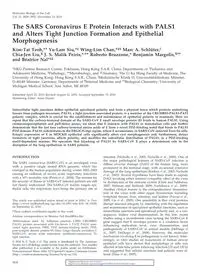
2010 The SARS Coronavirus E Protein Interacts with PALS1 and Alters Tight Junction Formation and Epithelial Morphogenesi PDF
Preview 2010 The SARS Coronavirus E Protein Interacts with PALS1 and Alters Tight Junction Formation and Epithelial Morphogenesi
Molecular Biology of the Cell Vol. 21, 3838–3852, November 15, 2010 The SARS Coronavirus E Protein Interacts with PALS1 and Alters Tight Junction Formation and Epithelial Morphogenesis Kim-Tat Teoh,*† Yu-Lam Siu,*‡ Wing-Lim Chan,*‡§ Marc A. Schlu¨ter,� Chia-Jen Liu,¶ J. S. Malik Peiris,*,** Roberto Bruzzone,* Benjamin Margolis,¶†† and Be´atrice Nal*‡‡ *HKU-Pasteur Research Centre, Pokfulam, Hong Kong S.A.R. China; Departments of †Pediatrics and Adolescent Medicine, §Pathology, **Microbiology, and ‡‡Anatomy, The Li Ka Shing Faculty of Medicine, The University of Hong Kong, Hong Kong S.A.R., China; �Medizinische Klinik D, Universita¨tsklinikum Mu¨nster, D-48149 Mu¨nster, Germany; Departments of ¶Internal Medicine and ††Biological Chemistry, University of Michigan Medical School, Ann Arbor, MI 48109 Submitted April 22, 2010; Revised August 16, 2010; Accepted September 15, 2010 Monitoring Editor: Asma Nusrat Intercellular tight junctions define epithelial apicobasal polarity and form a physical fence which protects underlying tissues from pathogen invasions. PALS1, a tight junction-associated protein, is a member of the CRUMBS3-PALS1-PATJ polarity complex, which is crucial for the establishment and maintenance of epithelial polarity in mammals. Here we report that the carboxy-terminal domain of the SARS-CoV E small envelope protein (E) binds to human PALS1. Using coimmunoprecipitation and pull-down assays, we show that E interacts with PALS1 in mammalian cells and further demonstrate that the last four carboxy-terminal amino acids of E form a novel PDZ-binding motif that binds to PALS1 PDZ domain. PALS1 redistributes to the ERGIC/Golgi region, where E accumulates, in SARS-CoV–infected Vero E6 cells. Ectopic expression of E in MDCKII epithelial cells significantly alters cyst morphogenesis and, furthermore, delays formation of tight junctions, affects polarity, and modifies the subcellular distribution of PALS1, in a PDZ-binding motif-dependent manner. We speculate that hijacking of PALS1 by SARS-CoV E plays a determinant role in the disruption of the lung epithelium in SARS patients. INTRODUCTION The SARS coronavirus (SARS-CoV) is an enveloped virus with a positive single strand RNA genome, which has emerged in the human population during winter 2002–2003 causing an outbreak of severe acute respiratory infections with a 10% mortality rate (Peiris et al., 2004). The reasons for the severity of illness in SARS-CoV infected patients are still not clearly understood. The SARS-CoV mainly targets epi- thelial cells, the respiratory tract being the primary site of infection (Nicholls et al., 2003; Nicholls et al., 2006). One of the major pathological features of SARS-CoV infection is diffuse alveolar damage (DAD) of the human lung, more prominent in the terminal stage, with occasional extensive damage of the lung epithelium (Kuiken et al., 2003; Nicholls et al., 2003). Several hypotheses have been made to explain DAD, invoking either intrinsic cytopathic effect of the virus or dysfunction of the immune system (Chen and Subbarao, 2007; Perlman and Netland, 2009; Yoshikawa et al., 2009). Another clinical feature is the extrapulmonary dissemina- tion of the virus with other organ dysfunction including lymphoid tissues, liver, intestine, and kidney (Farcas et al., 2005; Gu et al., 2005). One possibility is that viral proteins disrupt mucosal integrity by interfering with the regulation and maintenance of specialized epithelial functions, such as intercellular junctions and apicobasal polarity and, as a con- sequence, induce viral dissemination. In this line, recent studies using a recombinant virus lacking the SARS-Cov E gene suggest that E envelope protein is a virulence factor influencing replication level, virus dissemination, and pathogenicity of SARS-CoV in animal models (DeDiego et al., 2007; DeDiego et al., 2008). However, the molecular mechanism involving E in pathogenesis is not known. Inter- estingly, in vitro studies on monolayers of human airway epithelial cells have shown that morphology of cells was affected at late time points following infection (72 and 120 h) and suggested that cellular junctions and polarity were al- tered (Sims et al., 2005). This article was published online ahead of print in MBoC in Press (http://www.molbiolcell.org/cgi/doi/10.1091/mbc.E10–04–0338) on September 22, 2010. ‡These authors contributed equally to this work. Address correspondence to: Be´atrice Nal (
